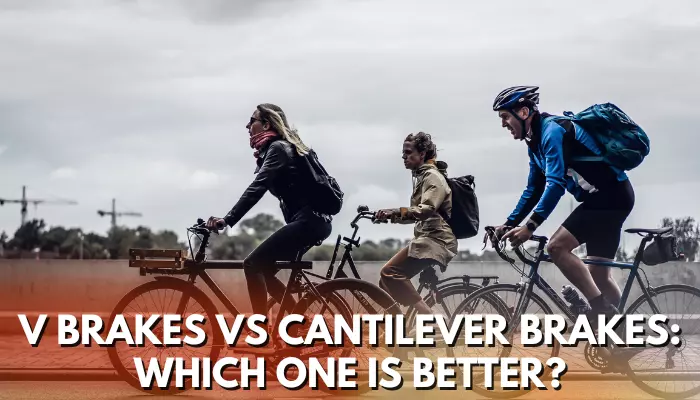V Brakes vs Cantilever Brakes: Which One Is Better?

Do you want to have a better brake for your bike? But you are confused about what to choose? Don’t worry; there are solutions to every problem. V brakes vs cantilever brakes are both beneficial for the right bike.
Table of Contents
Short Answer
Cantilever, disc, and V brakes are very common these days, and the cantilever and v brakes belong to caliper brakes. Both brakes have their pros and cons. To better understand V brakes vs cantilever brakes, you need to understand the use of these brakes along with the demand of a rider or the type of terrain you are planning to ride on.
The following article will help you with basic information about V brakes vs cantilever brakes.
V Brakes vs Cantilever Brakes:
Good bike brakes are essential parts of your bike component. It is the most critical because of the safety. Yes, good brakes provide good speed, but safety always comes first. The bike’s brakes should be manageable according to the terrain you are riding.
The two most common brakes are:
- Cantilever brakes and
- V- brakes.
We are here to discuss the V-brakes vs. cantilever brakes so that it might be easier to decide which one you should use for the bikes you plan to ride.
Are V-brakes and Cantilever Brakes the Same?
There are a few different types of rim brakes. The two standard rim brakes are V and cantilever, as the rims are various. Regarding the similarity of the brakes, the V brakes and the cantilever brakes are two very different things. Yes, the origin of the brakes is the same; they both are types of caliper brakes, which is why they are a bit similar. But they are two different brakes. The wires of the cantilever brakes are connected upside down at the V top of the brakes. There are two wires, whereas V brakes connect horizontally.
Linear Brakes:
V brakes are also known as linear brakes because the squeeze part of the brakes is flat and straight. They can easily be identified as two different brakes. To determine the V brakes, you need to follow the given facts:
The Identification:
To identify the brakes, check the front tire breaks, and check the connection of the brakes. If the wire is an upside-down V shape and connects at a single point above the tire, it is a cantilever brake.
The V shape of V-Brakes:
The v brakes don’t make a v shape when connected to the bike. They make the v shape when the brakes squeeze. The top gets drawn when the brakes are squeezed because the brake pads are in the middle of the arms; when it pushes the pads into the tire rim, the arms of the brake form V.
Do we consider V brakes Good?
To know or declare if any brake is good or bad, you have to have good information and try almost every brake out there to conclude anything. V brakes are very famous and common brakes used in different types of bikes.
And like mentioned above, the v brakes are better than the cantilever brakes. By comparing v brakes with others, the v brakes are excellent. They are the best rim brakes. The only brakes which are better than V brakes are the disc brakes.
Main Advantage of V brakes:
The main important point of v brakes is 2:
They can easily get squeezed, and they are easy to adjust once installed properly. Though disc brakes are better than V brakes, you don’t need to replace them with disc brakes if you have V brakes.
The Cost of the V Brakes with Disc Brake:
Although the disc brakes are more expensive than the v brakes, they are relatively cheaper after considering all things, the frame cost and other parts. The v brakes of top brands set you back around 30 dollars, and disc brakes around 100 dollars.
If the range of your bike is higher, that is 1000 dollars, then it doesn’t matter which brakes you are using, either disc brakes or V shaped brakes.
Why V brakes are Known as V brakes?
The wire where they meet is in the shape of a V in the case of cantilever brakes. But in the case of V brakes, they don’t make any V shape. Now what are the things that we call V brakes?
When they engage with the bike, they form an upside-down V. Otherwise; they make a U shape when they don’t connect with the bike’s wire. The U shape turns into a V because they draw together and make the top part shorten and make a V shape instead of a U. c
The lever squeezes, and the wire gets tightened. One lever handles the control front brake, and the other handlebar controls the back brake. After squeezing, the wire pulls and shortens the part of the brake at the top of the tire.
Which Brakes Are Better?
In terms of better brakes between V brakes vs Cantilever brakes:
Cantilever Brakes:
The cantilever brakes are more popular for clearance between the tire’s rim and the brake pads. The clearance means the mud doesn’t intervene in your brakes when you ride in wet conditions. The other important fact is the adjustment of the brake. The cantilever brakes are difficult to adjust because attaching the wire to the brake, arm losses, and the adjustment of both arms need to be secured adequately to attain the proper height and angle of cantilever brakes are difficult.
V-Brakes:
The V brakes also provide clearance but are not as straightforward as cantilever brakes. That means the V brakes can catch mud and dirt, resulting in challenging pedaling in some situations.
Whereas the adjustment of V brakes is easy and do it individually straddle wire, which allows you to balance wire tension easily. They are correctly fixed and won’t quickly lose their angle and height after setting it up. But it doesn’t mean you won’t keep checking on them. Time to time check is necessary.
Overview:
It is now apparent that v brakes are better than cantilever brakes, there is no doubt that cantilever brakes have more clearances, but v brakes are better in other aspects, which is more than one reason to choose V brakes.
According to ARPN, the Journal of Engineering and Applied Sciences, cantilever brakes are the old v brake levers. Due to the issues occurring while using the cantilever, the manufacturer replaced it with V brakes and manufactured it in a more straightforward shape.
Closure Difference of Cantilever Brakes and V-Brakes:
For a better understanding of V brakes vs cantilever brakes, have a closer look at the difference between the two brakes:
Mechanical Advantage:
The mechanical advantage of the brakes is the first thing to observe before buying the brakes. The book Bikes, Torque, and Forces are representative of automatic benefits. The mechanical advantage of a bike are the amount of braking force a brake can produce by the effort given by the rider to squeeze brake levers.
Whereas the cantilever’s mechanical advantage is much lower, the rider requires a greater input force to create the friction force against the rim and decelerate the bike.
The v brakes don’t need to feed the brake levers to provide more power to produce friction.
Braking Force:
The cantilever cable has transverse cable brakes, absent in V brakes. That is why the V brakes straddle wire in a better position when pulling the arm brakes because a better pulling angle will give more pressure on the brake arms and pads when the brakes squeeze. So, as a result, the braking force of the V brakes is much better than the cantilever brakes. Less brake travel is also present in V brakes due to the excellent friction produced against the rim by the brakes.
Modulation of the Brakes:
Due to the brake pads, the bike stops rubbing against the tire rim. According to the Institute of Technology in Massachusetts, the brake pads have rubber so that the brakes can create high friction.
Though the material used in both brakes is the same, the brake modulation of the cantilever has better brake pads. They are larger brake pads as compared to V brakes. The larger the brake pads a brake has, the better it would be to come in contact with the tire’s rim.
Maintenance of the Brakes:
As described above, the adjustment of the cantilever brakes isn’t good enough. The wire of the brakes needs to be adjusted on both sides of the bike. Brakes usually have more parts, and it can be overwhelming, especially if you aren’t aware of the brakes. Cantilever pads are independently moveable, so they go everywhere when we adjust the brakes.
As far as V brakes are concerned, they are easy to adjust and have only one cable. The brakes don’t have many parts like cantilever parts. The bolts of the V brakes aren’t loose; they are fixed tightly once adjusted. They don’t move around like cantilever brake pads.
Can we replace the cantilever brakes with V brakes on the same bike?
Yes, replacing the cantilever brakes on the same bike with the V brakes is possible. There are videos available to learn how to safely change or replace the cantilever brakes with the V-shaped brakes on the same bike.
What are the steps to Clean Cantilever Brakes?
Following are the quick ways to clean the cantilever brakes:
1. Lose the bolt of the caliper brakes
2. Remove the brake caliper.
3. Check the brake pad.
4. Now, clean the parts and lubricate them before reattaching them.
5. After proper cleaning, reattach the cable brake to the calipers.1
Which Side Of The Brakes Will Wear Down Faster?
The front one. The front brake pads will wear down in comparison to the rear brakes. Due to the maximum pressure bears by the front brake pads given by the vehicle. Sometimes the friction and overheating also happen to wear the brake pads more often.
Conclusion:
In conclusion, the V brakes and cantilever brakes have similar mechanisms. Both brakes use brake pads to squeeze to create friction against the front tire’s rim, resulting in decelerating rotation. V brakes vs Cantilever brakes, V brakes are more friendly brakes, and the only thing you need to make adjustments with is to adjust them occasionally. They are considerably more modern than cantilever brakes and require less power input to bring the bike to a stop.
Hopefully, the article gives you a better perception of which brake we should use: the cantilever or the V brakes. Before choosing brakes or any other bike component, research because the suitable part will give you a safer ride.

One Comment